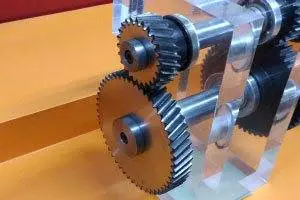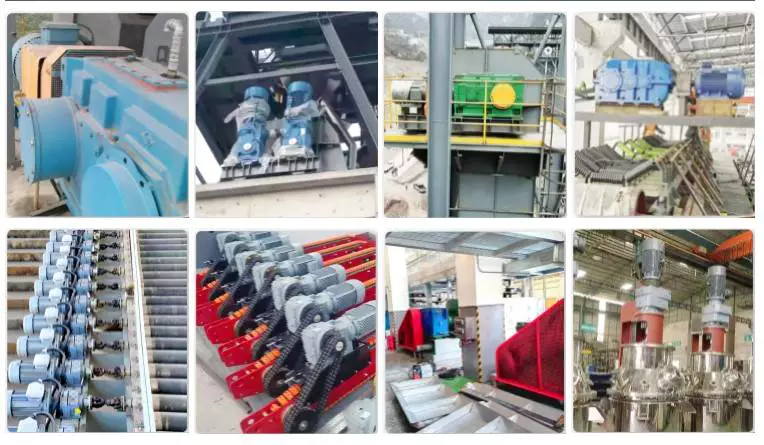Product Description
SC Transmission long life F Series parallel shaft helical reduction FA97 gearbox with 10hp motor electric motor speed reducer
Model:37~167
Ratio:3.77~281.71
Input power:0.12~250kW
Output torque:3.5~37125N.m
Product overview:
F parallel helical gear reducer is manufactured according to international technical requirements, with high technology content.
saving space, reliable and durable, high overload capacity, power up to 90KW above.
low energy consumption, superior performance, reducer efficiency as high as 95%.
small vibration, low noise, high energy saving, selection of high-quality steel materials, steel cast iron box, gear surface after high-frequency heat treatment.
after precision processing, to ensure the accuracy of shaft parallelism and positioning, which all constitute the gear transmission assembly deceleration motor configuration of all kinds of motors, forming an electromechanical integration, fully ensure the quality characteristics of the product.
|
Size |
97 |
||
|
Structure |
FA |
||
|
Input power rating |
1.1-30kw |
||
|
Ration |
4.68-270.64 |
||
|
Maximum torque |
4300N.m |
||
|
Weight |
260kg |
||
Product Description
| Ratio | 3.77-276.77 |
| Input power | 0.12-200KW |
| Output torque | 3.5-21700N.m |
| Output speed | 5-352rpm |
| Mounting type | Foot mounted, foot mounted with CZPT shaft, output flange mounted, hollow shaft mounted, B5 flange mounted with hollow shaft, foot mounted with hollow shaft, B14 flange mounted with hollow shaft, foot mounted with splined hole, foot mounted with shrink disk, hollow shaft mounted with anti-torque arm. |
| Input Method | Flange input(AM), shaft input(AD), inline AC motor input, or AQA servo motor |
| Brake Release | HF-manual release(lock in the brake release position), HR-manual release(autom-atic braking position) |
| Thermistor | TF(Thermistor protection PTC thermisto) TH(Thermistor protection Bimetal swotch) |
| Mounting Position | M1, M2, M3, M4, M5, M6 |
| Type | F37-F157 |
| Output shaft dis. | 25mm, 30mm, 35mm, 40mm, 50mm, 60mm, 70mm, 90mm, 110mm, 120mm |
| Housing material | HT200 high-strength cast iron from R37,47,57,67,77,87 |
| Housing material | HT250 High strength cast iron from R97 107,137,147, 157,167,187 |
| Heat treatment technology | carbonitriding and hardening treatment |
| Efficiency | 92%-94% |
| Lubricant | VG220 |
| Protection Class | IP55, F class |
Product Parameters
Company Profile
FAQ
Shipping
| Application: | Motor, Machinery, Agricultural Machinery |
|---|---|
| Hardness: | Hardened Tooth Surface |
| Installation: | Horizontal Type |
| Gear Shape: | Helical Gear |
| Step: | Single-Step |
| Type: | Gear Reducer |
| Samples: |
US$ 50/Piece
1 Piece(Min.Order) | |
|---|
| Customization: |
Available
| Customized Request |
|---|

Advantages of a Helical Gearbox
Usually helical gearboxes are used for industrial purposes. They are usually found in power generation units, where the input of energy is converted into output. There are several different types of helical gearboxes, including spiral and herringbone. You should familiarize yourself with the different types before choosing one for your project.
Helix angle
Generally, the angle between a gear tooth and its shaft axis is called the helix angle. This angle is important in motion conversion and power transfer. It is not to be confused with the lead angle, which is used to reference a line perpendicular to the axis of the gear.
The helical gearbox is used in several industrial applications. The oil and sugar industries, blowers, and feeders are among those that utilize helical gears. They are smoother than spur gears, and they also have quieter operation.
Helical gearboxes can be made modularly. This allows for more economical construction and interchangeability of components. These gearboxes are also used in enclosed gear systems. In a helical gearbox, each section of the box must stagger in a different direction. This helps in maintaining the integrity of the component.
Helical gears can be used in applications that require a high degree of quality control. This is necessary to minimize the effects of wear and tear. The use of extreme pressure lubricants is recommended for helical gears that operate at right angles. However, these are not recommended for bronze gears.
Besides the helix angle, the contact ratio also affects the performance of the gear. The more surface contact between the teeth, the greater the sliding. The heat produced is also detrimental to performance. It is necessary to use a lubricant that will reduce friction between the tooth surfaces. Proper lubrication reduces wear and minimizes heat.
When determining the optimum helix angle for a gear, it is important to consider the diameter of the gear. Helical gears have a minimum helix angle of 15 to 30 degrees. A higher helix angle increases the axial force generated by the gear, and a lower helix angle increases the contact stress.
Spiral gears
Using spiral gears in a helical gearbox offers several advantages, including smoothness and quiet operation. In addition, helical gearboxes are highly effective and can tolerate more load. Spiral gears are also more cost effective. However, they are more difficult to produce.
Helical gears are similar to spur gears in that they have teeth at an angle. However, the helix angle of the teeth in a helical gear is not fixed. This angle affects the position of the tooth’s contact with the mating gear. It also affects the normal force of the teeth.
The helix angle of the gear’s teeth is also dependent on the direction of rotation of the gear. For example, a spiral gear with a helix angle of 15 degrees is usually perpendicular to the axis of the gear. Similarly, a helical gear with a helix angle of 30 degrees is usually oblique to the axis of the gear.
Helical gears also provide a method for connecting shafts that are not parallel. These gears are usually used in industries such as conveyors, food industries, plastic industries, and oil industries. The main advantage of helical gears is that they are smoother than spur gears. However, the downside is higher wear and friction.
Helical gears are also used to transmit motion between parallel shafts. Helical gears are also used in high-load applications. This makes them a good choice for heavy-duty applications.
Helical gears are also superior to spur gears in load carrying capacity. Helical gears are smoother and quieter than spur gears. However, they also have a higher friction factor. In addition, they require special hobbing cutters.
Helical gears can also be classified according to their reference section in the standard plane. The center gap of helical gears with a reference section in the turning plane is the same as that of spur gears.
Herringbone gears
Among the different types of gearboxes, the helical gearbox is one of the most common. It is widely used in industrial applications, such as geared motors, worm gearboxes, and planetary gear trains.
A helical gear is a directional gear with a vertical axis. Its unique feature is the helix angle, which is the angle of the helix on the indexing cylindrical surface. The helix angle is set to a value of eight to fifteen degrees in design. The real radial pitch, which is the pitch of the gear when it rotates clockwise, varies with the helix angle.
Helical gears are classified according to the reference section in the turning and standard planes. Helical gears with a reference section in the standard plane have the same number of teeth as spur gears. On the other hand, helical gears with a reference section in a turning plane have the same center gap as spur gears.
The main advantage of helical gears is the high power-to-weight ratio. Aside from that, they are compact and have good meshing performance.
Another advantage is their high torque carrying capacity. This can be achieved by increasing the helix angle. The larger the helix angle, the smoother the gear’s motion. Moreover, the larger the helix angle, the larger the coincidence degree. This is useful in applications with high shock and vibration.
The production process for herringbone gears is more difficult and expensive than the other types. It is difficult to cut and shape herringbone gears. A simple gear hobbing machine is not suitable for this type of gear. However, the milling process can be used to process some herringbone gears.
Some of the problems related to herringbone gears are a lack of axial load, high friction and the interference of axial component forces. The meshing of teeth in herringbone gears can help reduce these problems.
Noise, vibration & harshness (NVH) characteristics
NVH testing is an important aspect of new driveline product development. It is typically performed during passenger car development, and is used for quality assurance of exterior and interior noise. This is an important topic in hybrid vehicles and electric vehicles, and continues to grow as the automotive industry expands.
A typical NVH test involves a rolling road dynamometer and signals are recorded and stored on a hard disk. These are then processed to produce variation distributions. Among other things, a lumped parameter system dynamics model was developed to run large size DOE studies efficiently.
Among the many components in the NVH chain, the bevel gear plays a major role in the final drive. Its characteristics are complex and time-varying, but they are important enough to be studied.
A new bevel gear OTE calculation method will be discussed in this paper. It is important to note that the NVH performance of an electric drive helical gear transmission system can be improved by thermal deformation of the bearing. It is also possible to achieve robust NVH performance in aluminum axle design by optimizing gear design, bearing optimization, and driveline system dynamics.
The gear train also has some lesser-known NVH performance characteristics. It is known that a gear train is an excitation source, and this is the topic of another study. It is also important to note that a helical gear system will exhibit non-linear behaviors when it changes working speed.
Applications
Compared to spur gears, helical gears offer greater load carrying capacity and smoother operation. They are also quieter, as the gears have larger teeth. These are the main reasons for their widespread use.
The main difference between helical gears and spur gears is the way teeth are cut. Teeth in helical gears are cut at an angle, in order to allow more teeth to interact in the same direction. This reduces shock loads and vibration. Helical gears are also much more durable than spur gears.
Helical gears can be used in a variety of applications. They are often chosen over spur gears for applications that require non-parallel shafts. They are also popular in the printing industry, the plastics industry, and the cement industry. They can also be used in conveyors and coolers.
Helical gears are made of a material that provides excellent durability, corrosion resistance, and a strong working load. They are also less expensive to produce. They are attached to a shaft using a press fit or adhesive. The attachment method can be a hub or an integral shaft.
Helical gears are also produced in a radial module form. This is the most economical option. This allows helical gears to be manufactured in a compact format. It also ensures that the bearing positioning requirements are met.
Helical gears are also produced with special grinding stones. These are needed for every helix angle. The helix angle determines the real radial pitch. This also affects the normal force of the tooth.
When mating helical gears to parallel shafts, they are right-handed. These gears can be made with a normal module set or by using special hobbing tools.

editor by CX 2023-04-28